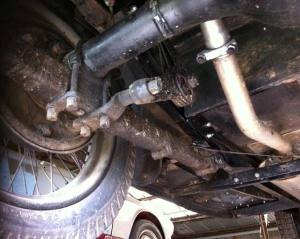Yesterday Crispin Thetford showed me two gearboxes laid out on the bench: one a modern synchromesh and the other a crash gearbox. You have to remember that I’m someone whose idea of what goes on under the bonnet of the car is similar to mankind’s knowledge about the deepest depths of the ocean – murky, to say the least. So it was a revelation to me to see what is actually happening in a crash gearbox when I crunch – I mean change smoothly through – the gears.
Now here’s my explanation. This is ‘Gearboxes, Key Stage 1’.
The gear machinery is essentially linear (not what I imagined, for some reason), with two ‘axles’ side by side with rings of cogs, which engage with each other. One of these ‘axles’ slides along its length, moving its row of cogs along to engage differently with the adjacent ones. (OK – this is a lay person’s version!) At the input end is the spin produced by the engine, at the other is the output to the moving parts, ie wheels, ultimately. The gears in between engage the spin with the required effort (is this the same as torque? Stop laughing, you experts, I’m doing my best!). In the one I was looking at (a vintage Riley), as in the Singer, there are three cogs to engage for 1st, 2nd and third gear (going up in size accordingly). For the fourth gear – and here’s the real punchline – cogs slides right up to engage directly with the input from the engine, so that in fourth gear, the speed of the engine and the speed of the output to the wheels are the same. This last ring of cogs aren’t fixed like a collar with the ‘teeth’ outwards, but upwards, where they engage with others facing them. You have to have the two pieces moving at the same speed in order for them to click together.
So, to go down from fourth to third (my bete noir at the moment) you put the car into neutral with the first push on the clutch pedal, then rev the engine to make the input bit go faster (have I lost you here) to match what the car engine would sound like to go at the speed you are aiming at in third gear. Then clutch pedal in again, slide smoothly into third. You hope.
Right then, you car buffs; after you’ve stopped laughing, perhaps you can mark me out of 10.
For a proper explanation, you’ll have to wait until Crispin has time on his hands to include it in his own excellent blog at Thetford Motor Engineering










